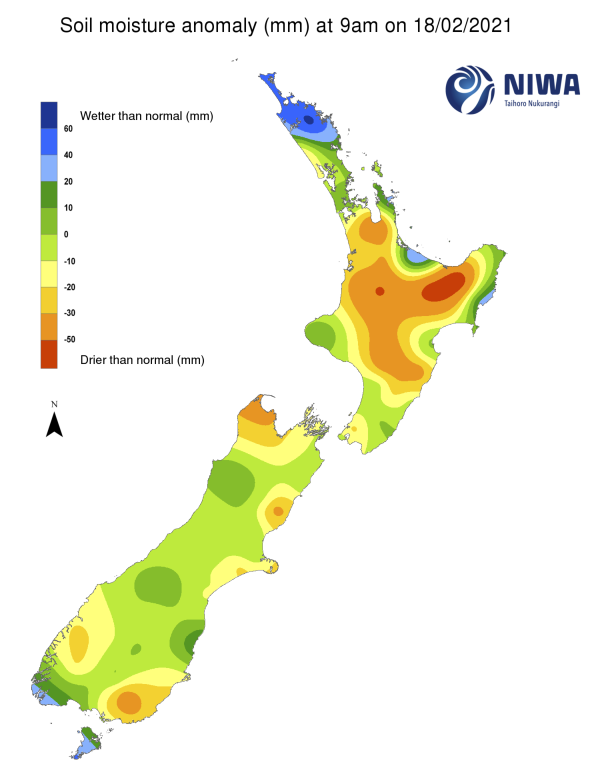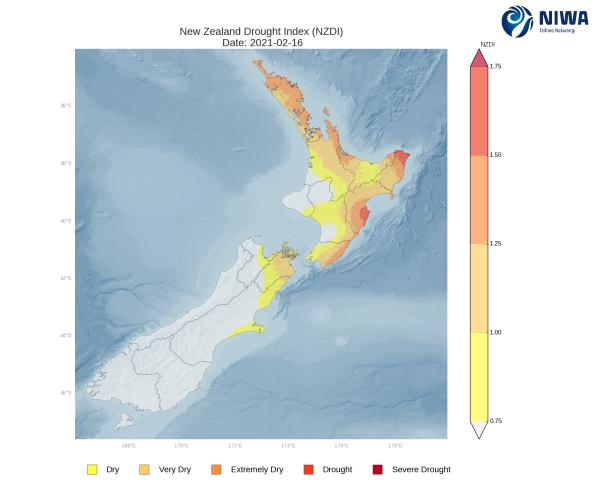A weekly update describing soil moisture patterns across the country to show where dry to extremely dry conditions are occurring or imminent. Regions experiencing significant soil moisture deficits are deemed “hotspots”. Persistent hotspot regions have the potential to develop into drought.
Facts: Soil Moisture
The upper, eastern and western North Island saw heavy rainfall over the past week, with many locations receiving over 50mm while some areas recorded over 100mm about the Far North, the Coromandel and southern Gisborne regions. However, central areas of the North Island, including most of Waikato and Manawatū-Whanganui regions, received less than 30mm of rain. As a result, northern and eastern areas saw increases in soil moisture over the last week, while central areas saw little change to soil moisture. The driest soils across the North Island, when compared to normal for this time of year, are found in the eastern Bay of Plenty.
Hotspots have eased for Northland, central and northern Auckland, western Bay of Plenty, coastal Taranaki, and much of the east coast from East Cape to Wairarapa. Hotspots remain in southern Auckland, northern and eastern Waikato, inland and eastern Bay of Plenty, northern and central Manawatū-Whanganui, Tararua District, and a small area near Wellington City. The New Zealand Drought Index (NZDI) map below (last updated on the 16th of February) shows that meteorological drought and severe meteorological drought has eased in the northern half of the Far North District. Meteorological drought remains for parts of East Cape and has now developed in southeastern Hawke’s Bay (however this may ease slightly when the next NZDI map is released on 19 February, which will take into account rain falling on 16 February). Widespread dry-to-extremely dry soils are in place for all other areas of the North Island excluding most of Taranaki, southern Waikato, central Manawatū-Whanganui, and Tararua District.
In the South Island, meagre rainfall was recorded in the last week, with most areas receiving less than 20mm and some western and central areas observing no rainfall. This resulted in small-to-moderate soil moisture decreases throughout the South Island. The driest soils in the South Island compared to normal for this time of year are located in Tasman, Hurunui, southern Otago, and eastern Southland (about Gore and Clutha).
Hotspots are currently in place in small parts of northern Tasman, coastal Hurunui District, and small parts of Gore and Clutha Districts. The New Zealand Drought Index (NZDI) map below shows that dry-to-very dry soils are found in the northeastern South Island and along parts of eastern Canterbury.
Outlook and Soil Moisture
High pressure overhead will bring dry weather to the North Island during this coming weekend and early next week. There is a chance of isolated showers for some northern and central areas from Wednesday (24 February) and into Thursday. Weekly cumulative rainfall will generally be less than 10mm. Meanwhile, weekly totals in the lower North Island could be very minimal.
Due to the expected weekly rainfall, soil moisture decreases are expected across much of the North Island. As a result, hotspots that are currently in place across the North Island are expected to strengthen and expand next week. Some hotspots may re-emerge in parts of western Northland.
High pressure is expected to bring dry weather to the South Island this weekend and into early next week. However, heavy rain may develop across the West Coast on Tuesday (23 February) and continue into Wednesday. Weekly rainfall totals could exceed 100mm across parts of the western South Island. However, weekly rainfall totals are expected to be much lighter across eastern areas of the South Island, generally remaining below 20mm.
Heavy rainfall in the next week across the western South Island will likely result in soil moisture increases, while soil moisture decreases are expected across much of the east. Most current hotspots are expected to slightly strengthen, except the one in northern Tasman which may weaken if enough rain falls.
Background:
Hotspot Watch: a weekly advisory service for New Zealand media. It provides soil moisture and precipitation measurements around the country to help assess whether extremely dry conditions are imminent.
Soil moisture deficit: the amount of water needed to bring the soil moisture content back to field capacity, which is the maximum amount of water the soil can hold.
Soil moisture anomaly: the difference between the historical normal soil moisture deficit (or surplus) for a given time of year and actual soil moisture deficits.
Definitions: “Extremely” and “severely” dry soils are based on a combination of the current soil moisture status and the difference from normal soil moisture (see soil moisture maps)
Hotspot: A hotspot is declared if soils are "severely drier than normal" which occurs when Soil Moisture Deficit (SMD) is less than -110 mm AND the Soil Moisture Anomaly is less than -20 mm.
Pictured above: Soil Moisture Anomaly Maps, relative to this time of year. The maps show soil moisture anomaly for the past two weeks.
New Zealand Drought Index (NZDI)
As of 16 February, the New Zealand Drought Index (NZDI) map below shows that meteorological drought and severe meteorological drought has eased in the northern half of the Far North District. Meteorological drought remains for parts of East Cape and has now developed in southeastern Hawke’s Bay (however this may ease slightly when the next NZDI map is released on 19 February , which will take into account rain falling on 16 February). Widespread dry-to-extremely dry soils are in place for all other areas of the North Island excluding most of Taranaki, southern Waikato, central Manawatū-Whanganui, and Tararua District, while dry-to-very dry soils are found in the northeastern South Island and along parts of eastern Canterbury. Please note: some hotspots in the text above may not correspond with the NZDI map. This difference exists because the NZDI uses additional dryness indices, including one which integrates the rainfall deficit over the past 60 days. Changes are therefore slower to appear in the NZDI compared to soil moisture anomaly maps that are instantaneously updated.




